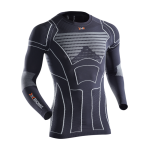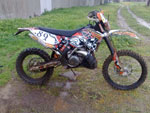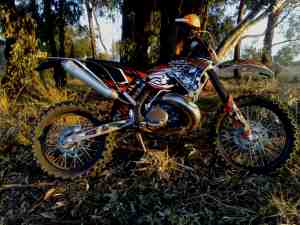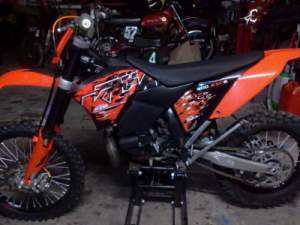BEARR News & Useful Resources
We'll be posting all the latest Website news and useful tips, hints and articles regularly so make sure you keep checking this page.
Kustom Bilt - Custom Services
8th July, 2016
We can carry out all kinds of Custom work, on bikes cars and trucks. These range from small "brush up" jobs right through to full rebuilds and makeovers.
See full details on the Kustom Bilt page.
Holeshot Performance Number Plate Bag Review
25th Sept, 2014
The Holeshot Performance Number Plate Bag is designed for top, easy access to your essentials, conveniently located in front of your bike's number plate. A couple of straps, a few buckles and it's ready to use.
The Holeshot Performance Number Plate Bag has an easy to use, larger zipper opening that is designed to allow quick and easy access to your gear. The bag is made from heavy weight, coated material that provides all weather protection. Inside the main pouch is a clear plastic sub-compartment.
Performance
Based on what Holeshot Performance claimed for the product, I'd say that they hit the mark well.
The large, main zipper opens up approximately 80% of the way around the bag, making access to your stuff a breeze. The small downside to the long zippered access is that if you have many smaller items in main pouch and open the zipper all the way, you may find some of stuff hitting the ground. I just put these smaller items in a smallish "stuff" sack inside the main compartment and problem solved.
Overall, the bag is large enough to carry the typical stuff. The main compartment is approximately 12" x 10" x 3" and will easily fit a trail side lunch, beverage, cell phone, spare gloves, keys, and other essentials. Made from heavy weight, coated nylon fabric, it withstood pokes, jabs, and brushes with all kinds of trees and scrub brush, as well as splashes from a few creek crossings without leaking.
Once strapped down, the bag remained in place well. The bag did bounce around and move enough against the plate that when combined with dirt and some mud, it caused a bit of wear on my number plate decal. If you have a nice, custom number plate background with your racing number and name or an irreplaceable, signed plate from your favorite racer, I’d suggest swapping out that number plate for a plain one.
Pros
- No tools required to install or uninstall
- Large access zipper
- Secondary pocket for organization of key items
- Quick, easy, top access to your essentials
Cons
- Bag, once opened fully can allow smaller items to fall from the main compartment
- Causes minor number plate scuffing
Conclusion
The Holeshot Performance Number Plate Bag fit my needs well for a non-headlight equipped trail bike. I very much liked having my spare gloves, a snack, and my cell phone at arm's reach while seated on the bike. Bag construction was done well as is the interior design. Adding a small gusset between the main pouch and the zippered front to help retain items in the bag would just be icing on the cake.
See full article, and much more, here on Thumpertalk.
Who warms up their engine?
25th Sept, 2014
Extracted from Thumper Talk.
Whenever I’m out and about either riding my motorcycle or participating in racing events occasionally I see things that just make me wonder "why"? One of those moments is when I see someone take a cold bike and fire it up for the first time and bang it off the rev limiter, start riding it immediately, or annoyingly continuously blip the throttle as if it will never idle on its own.
These actions beg the question, "Why is it important to warm up an engine"? The answer lies in a simple explanation of science and mathematics.
The solution revolves around the concept of linear thermal expansion. Your engine is made up of a number of different materials. The piston is made from a certain type of aluminum alloy, the cylinder another type of aluminum alloy, the rings cast iron or steel, the valves if you have a four-stroke from steel, stainless, steel, or titanium, and the guides are made from yet another material. Once the engine is started these components begin to heat up from combustion and friction as they slide back and forth. None of these materials are exactly alike, and because of this they will expand when heated or contract when cooled at different rates. This interaction between material and change in temperature is predictable and linear.
When a cold engine is first started the piston heats up and expands first. Heat is transferred from the piston to the rings and then to the cylinder wall. If we rev the engine and generate lots of combustion cycles and increase the frequency of friction too early the piston will grow much faster than the cylinder.
By allowing your engine to warm up before you start riding you allow all the components in the engine to slowly expand and stabilize. Once the engine is warm, changes in the engine part dimensions are less drastic and there is much less risk of damaging the engine.
Which leads us to the questions: "how do I know when my engine has properly warmed up then?" and, "what exactly do I do to properly warm it up?"
In essence, the procedure for warming up the engine is simple:
- Start the engine using the choke if necessary
- Once the idle comes up due to the choke turn the choke off
- Allow the engine to idle with the choke off until the cooling system warms up and the engine comes up to temperature
Knowing when the engine is ready to ride is a bit subjective. As you begin to pay closer attention to your engine, you will begin to detect when it is ready to ride.
See full article, and much more, here on Thumpertalk.
How to Select the Right MX, Off-road, or Dual-sport tyres
9th Sept, 2014
Found an interesting article on ThumperTalk about tyre selection. Reproduced some of the main points below together with a link to the full article.
WHERE ARE YOU RIDING?
Answers may range from "rocky steep trails" to "sandy motocross tracks" and as different as these two answers are, so are the tyres required to do the job.
1) MOTOCROSS
You’ll hear terms like "soft" and "hard" tyres and we’ve always found this confusing.
Simply put, soft tyres are for hard terrain: rocky, hard-pack tracks that can get blue grooved. These tracks require a soft compound tyre so the knobs can wrap around and conform to the track surface, thereby achieving more rubber on the ground for better traction.
Quality tyres choices in this category include the new Dunlop MX52, the Michelin MS3 and Bridgestone M204.
Hard/Intermediate tyres are for softer terrain: muddy, sandy or lots of loam covered tracks that can get very deep with wide ruts. These tracks require a harder compound tyre so the widely spaced knobs can dig in and create their own line, thereby achieving more rubber on the ground for better traction.
Quality tyre choices in this category include the Dunlop MX32, Michelin MH3 and the new Pirelli Scorpion MXMH 554.
2) ENDURO and HARE SCRAMBLES
The same terms as noted above are used for these types of tyres but there’s even a wider range of choices and sizes, as enduro bikes can use either an 18"or 19" rear tyre. Some enduro pilots like to use a motocross tyre but with the advances in tyre compounds and tread patterns, you’d be better off looking at what’s made specifically for this type of riding if you’re looking for optimal performance.
Dunlop tyre states "tyres for enduro and hare scrambles are similar since both are primarily run in softer, wetter, muddier terrain with slippery rocks and areas with exposed tree roots. Since some areas of these courses can be hard and slippery, the tyres must account for this as well. The tread compound used in these tyres must provide an optimum balance between wet and muddy terrain traction and long-wearing durability. Casing constructions must flex readily for riding over slippery rocks and tree roots, yet provide good puncture resistance. The tread pattern should clean well, even under the worst conditions, yet offer predictable handling in dry terrain."
Keeping this in mind, the Dunlop D606, Pirelli Scorpion Pro (highly rated by riders and racers we spoke with) and Metzeler MCE 6 Days Extreme are all good choices.
3) DUAL PURPOSE
This category can range from small on/off bikes like the Honda XL250 all the way up to ADV bikes like the KTM 1190 Adventure, so no broad choices are evident.
Michelin has seen a "noticeable increase in sales" of their 50/50 use tyres such as the T63 and AC 10. The Anakee III, which is an 80% on-road tyre, has been well received as a popular choice for adventure riders who venture off road occasionally. To capitalize on this growing segment, Michelin plans to expand the Anakee range for BMW GS riders who are looking for a high performance off-road oriented tyre(s) next year.
How much you ride on vs. off-road? This is the key in determining your tyre choice.
Are you a trail rider who only sees pavement on the way to the trails? You’ll need taller, more aggressive tread pattern with wider spacing.
Are you a street rider who occasionally wants to cruise down a fire road? You’ll need low profile, closely spaced tread pattern.
Dual purpose tyres are required to be DOT compliant and that mandates the tyres meet some guidelines that many off-road and racing tyres do not such as width, load capacity, speed ratings and minimum air pressures.
Another factor to keep in mind is that unlike some other off-road tyres, matching dual sport tyres up in a set is important to avoid handling issues on pavement and uneven wear front to back.
For example, a 90% street and 10% trail rider may pick a tyre like the Michelin Anakee 3. If the ratio is more like 50% street and 50% trail, a good pick is the Dunlop D908RR and if you ride mostly dirt, the Pirelli XCMH should provide good hookup when in the loose stuff.
See full article, and much more, here on Thumpertalk.
Stolen Bike Register updated
19th May, 2014
More listings added to the Stolen Bike register page.
Bionic Energizer Summerlight Gear
28th January, 2013
 NEWS:
We are currently seeing what kind of interest we have in these great performance products before placing a bulk order. See
full details on the Bearr Wear page.
NEWS:
We are currently seeing what kind of interest we have in these great performance products before placing a bulk order. See
full details on the Bearr Wear page.
Bionic X-SOCKS Available NOW!
5th June, 2012
 NEWS: X-SOCKS® Moto Cross Socks available from the BEARR.
NEWS: X-SOCKS® Moto Cross Socks available from the BEARR.
BEARRS Spares will be the sole moto distributer in OZ for the X-Bionics® range of suits, and we now have the amazing
Moto X-SOCKS® moto socks available for purchase. See
full details on the Bearr Wear page.
Stolen Bike Register updated
5th June, 2012
More listings added to the Stolen Bike register page.
Stolen Bike Register updated
5th November, 2010
More listings added to the Stolen Bike register page.
Wiseco Piston Kits
15th April, 2010
The BEARR has unearthed a source for hard-to-find TM & RM Wiseco Piston kits. From early TM to RM's up until 1982 -
from Std sizing to 2.00mm oversize. We have these at prices from just $280AUD to $320AUD, so there are some
great bargains to be found if you're looking for these rare items. Contact the BEARR right now if you're
after any TM/RM Wiseco Piston kits - we'll see if we can help.
Stolen Bike Register updated
25th August, 2009
More listings added to the Stolen Bike register page.
Beaut Bearr's Bike Picture
18th August, 2009
 The sexy KTM after the Donnybrook Enduro - you can click on the image to see a larger version:
The sexy KTM after the Donnybrook Enduro - you can click on the image to see a larger version:
Grinding Tips
13th May, 2009
Our good friends at Thumper Talk have put together this nice little piece on 'Looking Ahead'.
"There are some really great benefits to looking ahead as you roost down the trail. As discussed in some of these previous tips doing this gives a better sense of balance which in turn decreases your chances of getting out of control down the trail and having to get off the gas. The golden rule we like to use is that you should be..."
See the FULL post.
BEARR's 2009 Bike!
29th April, 2009
Check out these pics of the beautifully decked-out BEARRS Bikes all pumped and ready for the
2009 season - you can click on the images to see a larger version:

2008 KTM 300 EXC-e with custom factory grahpics in BEARRS RACING
colours. Stock standard with development work to be carried out throughout
the '09 Enduro and Offroad season. We will post regular updates as we perform these mods to let
you know how they go i.e. performance pipe, carb mods, fork & shock adjustment
etc.

Custom Graphics can be ordered in any scheme you desire - just Contact BEARRS & make an enquiry.
Grinding Tips
17th March, 2009
Our good friends at Thumper Talk have put together this nice little piece on 'Grinding'.
"Grinding is our second Advanced fundamental skill, and just like precise wheel placement which we discussed last month, we use this skill to avoid and conquer so many nasty trail obstacles such as long, deep ruts. This skill is also a big help in us being able to maintain control and forward motion of the bike if you or the bike get off balance. It is preferable to do this skill while in the standing position for increased upper body movement to help maintain control and balance..."
See the FULL Grinding post.
New Website
14th March, 2009
We are pleased to lauch the new look BEARRS Spares Website. We've retained the clean look and
easy navigation but we've added a whole heap of new content and sections.Please browse around
the site, and let us know if you hit any errors.
Stolen Bike Register launched
12th March, 2009
The BEARR hates people who steal bikes - so we have set up a new area on the site where you can
view a Register of Stolen Bikes. What's more, if you are
unfortunate enough to have your Bike stolen you can, totally
FREE of charge, Add the details for us to list on the Register.
Beta Scooter Parts
12th February, 2009
The BEARR is very pleased to announce that he is now the official Australian distributor for all
Beta Scooter parts. You can view some schematic diagrams and parts lists at our
Beta Scooter Parts page.
